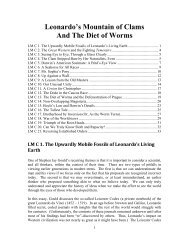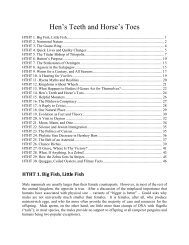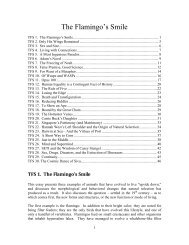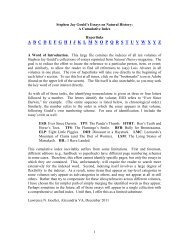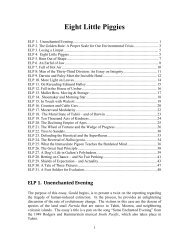Darwin’s theory, like Adam Smith’s in economics, involves only a metaphorical “unseenhand” and not a real one [see ELP 9]. As evidence that sexual selective forces inparticular work for the benefit of individuals rather than species, Gould offers severalillustrations, one of which is the peacock’s tail. This structure offers no advantage to thespecies as a whole, and in fact may work to limit its longevity. Its sole functions are toimpress females and discourage rival males, and thereby gain an individual advantageover other members of its own species.[While expressing direct support for Darwin’s view of natural selection, which is fullyconsistent with that of the modern evolutionary synthesis, this argument appears to differfrom Gould’s own quasi-revolutionary departure from this orthodoxy. Gould’s finalwork, The Structure of Evolutionary Theory, argues that evolution operates at a hierarchyof levels, one of which is, in practice, the species. His “out” comes from his extension ofthe term “Darwinian individual” from a single organism to include certain types ofaggregates that meet five distinct criteria. He discusses this concept explicitly in theseessays only rarely, but it is at the heart of the next one – DIH 26.]The second “Science Times” exchange subtly draws on the false notion that evolutionexhibits sensible directionality. The article itself suggested that, had the asteroid thatstruck the earth at the end of the Cretaceous period not impacted sulfur-rich rocks,“dinosaurs might well have survived the impact, thereby changing the course ofevolution.” Another letter to the editor challenged this particular choice of words. Thesubmitter wrote: “Actually, it was the demise of the dinosaurs that changed the course ofevolution. Had the dinosaurs not been wiped out, evolution would have continued on thesame path it had been following for at least 150 million years.” Gould criticizes both,arguing that both sides tacitly (and, no doubt, subconsciously) assume that evolutionfollows paths in one direction or another. This may appear to be a small point, but it isnot; such a view implies a determinism, effectively a destiny, in natural history that(Gould argues) is not present. There are no paths for evolution to follow.The third example involves the assumption of continuous evolutionary change, which inturn involves the spin-doctoring notion of evolutionary progress. Under the title“Evolution of Humans May Be Faltering,” the Times reporter (William K. Stevens)quotes scientists who note that modern man is anatomically indistinguishable from ourancestors of 100,000 years ago, well before Cro-Magnons made paintings in caves. Asan advocate for punctuated equilibrium and its concept of stasis, Gould found nothingobjectionable in the descriptive part of the article. His emphasis is instead on the implied“performance problem.” Stevens begins his article this way: “Natural evolutionary forcesare losing much of their power to shape the human species, scientists say, and therealization is raising tantalizing questions about where humanity will go from here. Ishuman evolution ending, ushering in a long maturity in which Homo sapiens persistspretty much unchanged?” Gould counters:Most species are stable during most of their geological duration. . . . I can onlyconclude that the spin doctored view of life’s history conceives of evolutionwithin species as a continuous flux of improvement and adaptation. We are32
particularly prone to expect such a result for our own species. After all, weevolved from small-brained ancestors, and we have achieved our exalted status bycranial enlargement. Shouldn’t this process, as intrinsic, be continued during ourperiod of maximal spread and success? Therefore, if we have truly stabilized,isn’t something funny going on, and mustn’t that something be an imposition ofour cultural discoveries upon our biological estate? No, no, a thousand times no.Our stability is orthodox – at least in a fully revolutionary Darwinism withsmashed pedestals.While he views humans as a small, fortuitous twig on a big bush, he does recognize andcelebrate the uniqueness of our ability to contemplate that bush and everything else. Thesmashing of these pedestals should not demoralize us, he argues; the truth sets us free,although it may force us to seek comfort and solace elsewhere. [He returns to the themeof Darwin’s unfinished revolution in LMC 15.]DIH 26. A Humongous Fungus Among Us<strong>In</strong> 1992, when Gould wrote this essay, a story appeared in The New York Times with theheadline “Thirty Acre Fungus Called World’s Largest Organism.” (The technical paperbehind it appeared in the journal Nature on the same day.) The newspaper, of course,focused on the size, weight, and age of this gigantic fungus, which is comprised mostly ofa large but thin matrix of connected threads within the soil, surfacing in a few places toform clumps of mushrooms. Large fungal mats were previously known to science, so thescientific aspect of importance was not in the size; rather, it was on the methodology usedto determine that the mat was indeed one organism and not several. Comparisons of thegenome from samples over the site were consistent with the single-organism view, and itwas known that different mats of the same species did not “merge” into one another butestablished distinct boundaries. However, since one mushroom can produce millions ofspores, an alternative possibility is that the fungal mat was the result of manyinterbreeding siblings that had spread out over a large area. An additional genetic testwas required to determine whether the mat was an individual or a group. To prove theformer, the authors showed that the genetic variability within the fungus was relativelyhigh. This is important because one of the results of extensive inbreeding is a markedreduction in genetic diversity; high variability thus indicates a single organism.Gould’s next step is to question the definition of “individual” in cases such as this type offungus, as well as grasses that send up many blades from underground runners. Hereferences another paper from the 1970’s that posits that aphids are analogous to grass inthis respect. [Gould discussed a related paper by the same author, Dan Janzen, in a muchearlier essay, ESD 11.] A female aphid will produce thousands of female offspring fromunfertilized eggs, all genetic clones of her and each other. Thus, in the perspective of thispaper, a colony of such aphids is really a single organism, just like grass only without thephysical connecting threads. (The female aphid eventually produces some males, andsexual reproduction occurs.) Perhaps the definition of “individual” is not as clear-cut asit might appear [also see TFS 4 & 5].33
- Page 4 and 5: cloud (“nebula”) of gas and dus
- Page 6 and 7: goodness, and is both intelligent a
- Page 9: The second news story involves the
- Page 12 and 13: key ways. Prior to 1994, no fossil
- Page 14: DIH 11. Lucy on the Earth in Stasis
- Page 17: directly resulted in a mass extinct
- Page 20 and 21: Edgar Allan Poe, it turns out, wrot
- Page 22 and 23: things male, while the beautiful is
- Page 24 and 25: interest, until the entrepreneur of
- Page 26 and 27: essay is that scientists, for all t
- Page 28 and 29: DIH 23. The Smoking Gun of Eugenics
- Page 30 and 31: half-Jewish meant Jewish, while qua
- Page 34 and 35: What might a better definition of t
- Page 36 and 37: type of soil, amount of rain, and s
- Page 38 and 39: Case Four, in Gould’s words, is
- Page 40 and 41: multiplying his findings by the num
- Page 42 and 43: other departments, something that r
- Page 44 and 45: Linnaeus, Gould states, did not sim
- Page 46: greatly prefers these metaphors, on




